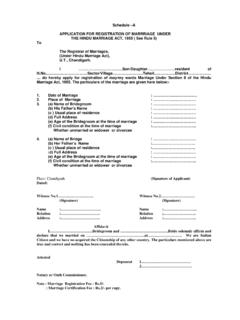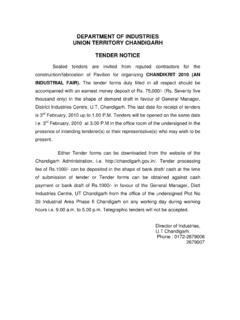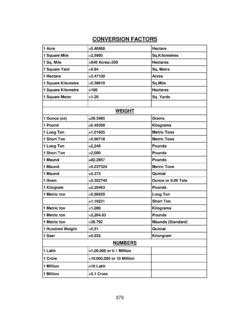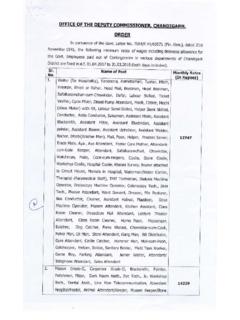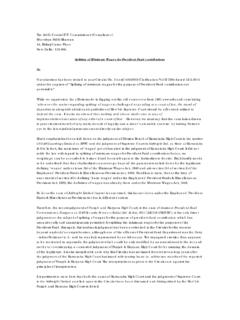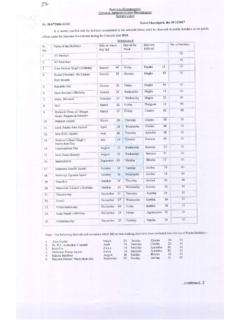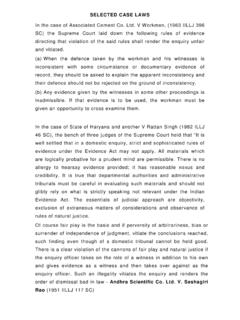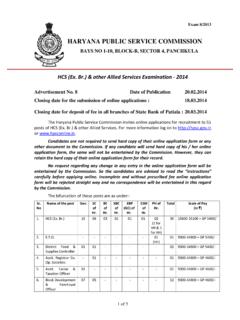Transcription of PUNJAB & HARYANA HIGH COURT CHANDIGARH
1 PUNJAB & HARYANA high COURT . CHANDIGARH . GOLDEN JUBILEE. EXHIBITION. high COURT at a Glance The endevour of this exhibition in the Golden Jubilee year of the high COURT is to have a look into the past. It provides us an opportunity of introspection and to know the historical development of this COURT so that we may enlighten ourselves and appreciate the journey undertaken by it to reach where it is today. The History of this COURT have been a fascinating growth of social and political affairs over which it has exercised jurisdiction. The Mughal Empire in the later years of its reign crumbled and in the 1790s the area of PUNJAB was in the disorganized state of affairs.
2 It was under the heads of various Sikh Misls' (Confederacies). The invasion of Ahmad Shah Abdali further compounded the otherwise already unstable administrative and judicial affairs. In this state of affairs, primitive customs and myriad rules were followed for the settlement of disputes through Panches'. There were no judicial courts, written laws or an authority to enforce and maintain them. The Judicial reforms started with the consolidation of PUNJAB under the Maharaja Ranjit Singh, who amongst others steps reorganized the Administration of Justice in the area under his domain.
3 The persons professing the Muslim faith were governed by the Shariat' law and for them separate courts were set up. Nazamdin was appointed Chief Qazi (Judge) with Mohammad Shah Puri and Saidullah Chishti as two Muftis. The Hindus and the Sikhs were governed by customary Law of their caste or the district, for which the Maharaja setup separate Courts under Judicial Officers appointed by the Durbar. A distinct COURT was set up at the capital known as Adalat-I-Ala. Not much is known as to how this COURT was constituted and who the Judges were, but its name suggests that it was probably an Appellate COURT akin to the high COURT .
4 With the death of the great Sikh Ruler, disorder and chaos prevailed once again. On 16th December, 1847 an Assembly of the Sikh misldars (Chieftans) was held in the durbar of the British Resident and a convention was signed appointing a Council of Regency under the British Resident who became the repository of authority in the territory of Maharaja Ranjit Singh. Soon there was a revolt against the British Residency. However, with the fall of Multan and the Battle of Gujrat, the position changed. The Sikh nobles assembled for the last time on 29th March, 1849, when Lord Dalhousie's proclamation was read out, on which Maharaja Duleep Singh was made to affix his initials.
5 The territory of PUNJAB thus stood transferred to the East India Company. With the annexation of PUNJAB , the British set up a Boar of Administration of three members having responsibility though separate charge of Political, Revenue and Judicial Administration. In the field of criminal law a Penal Code known as a PUNJAB Crimes Act was amongst the first written code to be applied in the province. The Board was however, abolished in 1853 and John Lawerence (Later Lord). was appointed as Chief Commissioner with two Principal Commissioners for judicial and administrative work. The Judicial Commissioner was the Chief Judge and his COURT was the final Appellate COURT .
6 Lord Maculay's Indian Penal Code was enforced in 1860 and Criminal Procedure Code followed. In civil matters the PUNJAB Civil Code was applied to the province in 1853-54, which was a complete set of Rules and Orders that had been issued in the Past. The PUNJAB courts Act (Act No. 19 of 1865) was enacted which inter-alia provided for seven classes of Courts to exercise Civil jurisdiction starting from the Tehsildar upto the COURT of Judicial commissioner. The Chief COURT Act (Act 23 if 1855) remained in force for a short span. In the following year in 1866 the Chief COURT (Act IV of 1866).
7 Received the assent of the Governor General on 16th February, 1866. the said Act constituted Chief COURT of PUNJAB as the ultimate COURT of Appeal of Civil and Criminal courts in the province. During this period Justice Ram Narain Dar (1849 to 1886) was elevated as the first Indian Judge of the Chief COURT . It was in 1877 by the PUNJAB COURT Act (XVII of 1877) that the PUNJAB Courts Act, 1865 and the Chief COURT , Act, 1866. were repealed. The new Act brought about some changes in the Civil Courts. The setting up of the Chief COURT in 1866, culminated in the constitution of the high COURT of Judicature at Lahore for the province of PUNJAB and Delhi on 21st March, 1919 by Letter Patent.
8 Thereby the status of Chief COURT was elevated to that of the high COURT . Another event of that year is the enactment of the Government of India Act, 1919 on 23rd December, 1919. one cannot miss making a reference to the noted legal luminary of this period Sir Shadi Lal, who was the first to qualify the Indian Civil Services (ICS) from this region in 1902 but resigned to start practice at Lahore. He belonged to Rewari and became a Barrister. He became a judge and Chief Justice of Chief COURT . He was one of the first six judges appointed as judge of the Lahore high COURT after its constitution.
9 He was conferred Knighthood on 1st January, 1921 and was amongst the first of the Indian judges who was elevated to Privy COURT . The Government of India Act 1935 substituted the 1919 Act which brought about changes in the composition of the COURT . The limitation that the Chief Justice had always to be a Barrister Judge was withdrawn. The Chief Justice could thereafter be appointed from amongst the civilian Judges as well. Besides, the age of retirement of a judge was fixed at 60. the Government of India ( high COURT Judges) Order 1937 fixed the number of Judges for the Lahore high COURT at 15.
10 It is during this period, out of the strength of permanent and additional Judges, three temporary Judges were specially deputed in 1930 to serve the Special Tribunal for the trial of Lahore Conspiracy Case, to which exhibits have been made available for display in the exhibition as also a write up from its judgment. Of the still earlier period, Kartar Singh Sarabha's case has been displayed by making a brief reference of its history. The year 1947 marked the end of the British era in the Indian history. The British Parliament passed the Indian Independence Act, 1947 which provided a free independent India, however, at the same time led to the partition of the country, the independent dominions of India and Pakistan were created.


